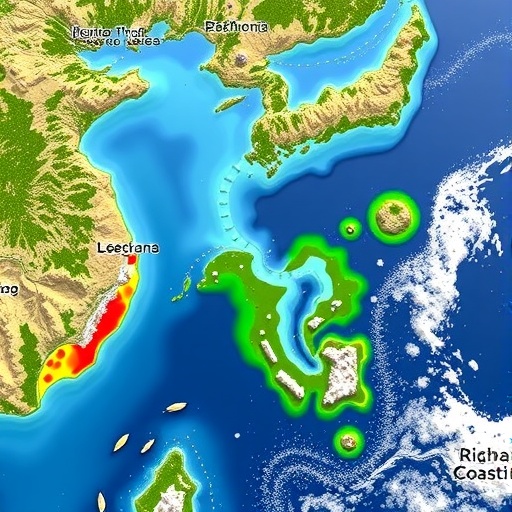A recent study presented in the journal Environmental Monitoring and Assessment focuses on the complexities of soil contamination migration, particularly concerning organic compounds in the coastal regions of Rizhao City, Shandong Province, China. The research led by scholars including Lu, Jia, and Liu employs cutting-edge simulation techniques to predict how various environmental scenarios influence the spread of these contaminants. With increasing industrial activities and urban development in coastal areas, understanding the dynamics of soil contamination has never been more crucial.
The researchers approach the problem from a multifaceted perspective, integrating ecological and chemical analyses to provide a nuanced understanding of how organic compounds interact with soil environments. Organic contaminants often have a tendency to bind with soil particles, but various factors can influence this interaction, including soil composition, moisture content, and microbial activity. The study meticulously details these interactions, which are vital for accurate contamination prediction and management strategies.
One of the primary aspects highlighted in the study is the significance of simulating different environmental scenarios. This method allows researchers to assess how changing conditions, such as rainfall patterns, temperature variations, and anthropogenic influences, can alter the trajectory of contaminant migration. For instance, increased rainfall can enhance runoff, leading to a more profound transport of pollutants into groundwater systems or adjacent ecosystems. The findings emphasize that without understanding these scenarios, efforts to mitigate soil contamination may fall short.
The researchers utilized advanced modeling software that simulates various conditions and physical properties of soil to predict the fate and transport of organic contaminants. These models are crucial as they enable projections over various time frames and under numerous scenarios, providing a comprehensive picture of how soil contamination could evolve under changing environmental policies or climate conditions. By utilizing these simulations, the team can establish baseline metrics that can inform future soil conservation efforts and health assessments.
In addition to simulation techniques, the research underscores the importance of field studies to validate model predictions. Rigorous sampling and monitoring of soil and water quality in the affected areas complement the simulation data, providing real-world evidence of the interaction between organic contaminants and environmental variables. This combined approach enhances the reliability of the predictions and offers a more thorough understanding of the risks posed by soil contamination.
Moreover, the study discusses the implications of these findings for policymakers and environmental agencies. Effective management plans must be informed by evidence-based studies that highlight the potential pathways and effects of soil contamination. The interdisciplinary nature of this research equips stakeholders with the necessary information to design interventions that are both effective and sustainable.
Furthermore, the push for public awareness regarding soil health is emphasized. The researchers advocate for increased educational efforts focused on the importance of maintaining unpolluted soils. Public engagement can serve as a critical component in the broader context of environmental stewardship, where informed and active community members can contribute to soil conservation efforts.
The researchers also touch on the legislation surrounding environmental protection in China, highlighting past measures and the need for renewed commitment to stricter regulations regarding pollutant management in coastal areas. They propose that amplified regulatory frameworks can significantly impact how industries operate and thus help in minimizing the risk of soil contamination from hazardous organic compounds.
Another significant element addressed in the study is the relationship between urbanization and soil health. As cities expand, the natural landscape undergoes transformations that often lead to increased degradation of soil quality. The balance between necessary urban development and environmental preservation is a critical challenge that the research brings to light, advocating for strategies that prioritize long-term soil health while accommodating necessary growth.
The amplification of these findings can resonate with several global contexts. The risks posed by organic soil contaminants are not limited to China; they are a universal concern that requires collaborative international efforts in research, policy formation, and implementation. The study serves to bridge local insights with global environmental challenges, reinforcing the interconnectedness of ecosystems.
In conclusion, this significant research advances our understanding of how soil contamination from organic compounds can be modeled and predicted under various scenarios. As the implications of this research unfold, it is anticipated to spark further investigations into innovative approaches to soil health preservation and contamination management. Such knowledge is indispensable for ensuring cleaner environments for future generations.
The impending strain on soil and water resources necessitates immediate and informed action. With rising global concern about environmental degradation, the findings of this study cannot be overlooked. They serve both as a warning and a guidepost for future environmental strategies aiming to mitigate soil contamination and promote sustainable development practices that are crucial in a rapidly changing world.
By leveraging both advanced technological modeling techniques and ground-level research, the study presents a rich dataset that not only portrays current challenges but also lays the groundwork for future inquiries into soil health and ecological stability. The importance of this research is underscored by its capacity to influence policy and provoke action, ultimately aiming toward healthier soils and stronger ecosystems.
This research offers invaluable insights that should resonate across scientific communities and policy-making bodies, highlighting urgent issues of soil contamination that demand immediate attention and collaborative solutions. Collectively, these narratives contribute to an ongoing dialogue about sustainability and environmental responsibility, championing the cause for cleaner, healthier soils worldwide.
Subject of Research: Soil contamination migration for organic compounds in coastal areas.
Article Title: Simulation and prediction of soil contamination migration for organic compounds under multiple scenarios in coastal areas of Rizhao City, Shandong Province.
Article References:
Lu, S., Jia, C., Liu, S. et al. Simulation and prediction of soil contamination migration for organic compounds under multiple scenarios in coastal areas of Rizhao City, Shandong Province.
Environ Monit Assess 197, 1323 (2025). https://doi.org/10.1007/s10661-025-14757-1
Image Credits: AI Generated
DOI: https://doi.org/10.1007/s10661-025-14757-1
Keywords: Soil contamination, organic compounds, environmental simulation, coastal areas, risk assessment, soil health, policy implications.




